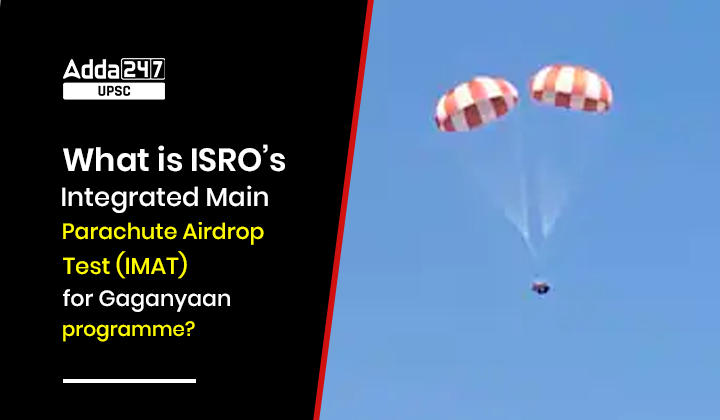Table of Contents
Significance of ISRO’s IMAT Test for Gaganyaan program for UPSC CSE
ISRO’s Integrated Main Parachute Airdrop Test, or IMAT Test for Gaganyaan program marks a significant milestone toward realizing the nation’s ambitious Gaganyaan project which is important progress that every UPSC aspirant need to be aware about it.
As, for UPSC CSE, every happening related to Gaganyaan program which is a National Programme is equally important.
ISRO’s IMAT Test for Gaganyaan program also covers GS 3: Space Technology.
Why ISRO’s IMAT Test for Gaganyaan program is in news?
On November 18, ISRO’s Vikram Sarabhai Space Centre, where many Gaganyaan activities are progressing, conducted a major development test ”Integrated Main Parachute Airdrop Test, or IMAT” of its crew module deceleration system at the Babina Field Fire Range (BFFR) in the Jhansi district of Uttar Pradesh.
Know About: Vyommitra Humanoid
What is Gaganyaan deceleration system for which IMAT test is conducted?
What is IMAT test?
- The IMAT test is the first in a series of integrated parachute airdrop tests planned to simulate different failure conditions of the parachute system before it is deemed qualified to be used in the first human spaceflight mission.
What is gaganyaan deceleration system?
- The Gaganyaan deceleration system consists of three main parachutes, besides the smaller ACS, pilot, and drogue parachutes, to reduce the speed of the crew module to safe levels during its landing.
- Two of the three main chutes are sufficient to land the astronauts on earth, and the third is redundant.
- The IMAT test simulated the case when one main chute failed to open.
How is the dummy IMAT test for Gaganyaan Program done?
- In this IMAT test for Gaganyaan Program, a five-tonne dummy mass, equivalent to the crew module mass(expected mass of Gaganyan Crew), was taken to an altitude of 2.5 kilometres and dropped using the Indian Air Force’s IL-76 aircraft.
- Two small pyro-based mortar-deployed pilot parachutes then pulled the main parachutes.
- The main parachute sizes were initially restricted to a smaller area to reduce the opening shock. After seven seconds, the pyro-based reefing line cutters cut the area restricting line, allowing the parachutes to inflate fully.
- The fully inflated main parachutes reduced the payload speed to a safe landing speed. The entire sequence lasted about 2-3 minutes as the scientists watched the different phases of the deployment sequence unfold with bated breath.
Did you Know about ISRO’s Gaganyaan Program?
- ISRO’s Gaganyaan is the first project taken up by ISRO for demonstrating human space flight capability.
- The Gaganyaan program envisages undertaking the demonstration of human spaceflight to LEO (Low Earth Orbit) with a crew of three astronauts to 400 km LEO.
- This task necessitates three major components, namely Human Rated Launch Vehicle, Crew Escape System and Orbital Module with human presence.
- Apart from this the Ground Control station is planned for the entire mission duration during ascent, on-orbit and descant phase of the mission.
- As per the mandate of Gaganyaan, two unmanned missions will be undertaken prior to the manned mission.
Know about: Gaganyaan Space Mission
Did you know about ISRO’s Vikram Sarabhai Space Centre?
- Vikram Sarabhai Space Centre (VSSC), Thiruvananthapuram, is the lead centre of ISRO responsible for the design and development of launch vehicle technology.
- The Centre pursues active research and development in the fields of aeronautics, avionics, materials, mechanisms, vehicle integration, chemicals, propulsion, space ordnance, structures, space physics and systems reliability.
- The Centre undertakes crucial responsibilities of design, manufacturing, analysis, development and testing related to the realisation of subsystems for the different missions.
- The major programmes at VSSC include Polar Satellite Launch Vehicle (PSLV), Geosynchronous Satellite Launch Vehicle (GSLV) and Rohini Sounding Rockets as well as the development of Geosynchronous Satellite Launch Vehicle (GSLV) Mk Ill, Reusable Launch Vehicles, advanced technology vehicles, air-breathing propulsion and critical technologies towards human spaceflight.
Gaganyaan Programme: ISRO Successfully Tests Solid Rocket Booster
What ISRO’s IMAT Test for Gaganyaan Program demonstrates?
- Gaganyaan is a National Programme wherein various National agencies will be collaborating with ISRO. The various stake holders include Indian Armed Forces, DRDO labs, Indian Industries, Premier Academic & Research institutions, CSIR labs, and various Industries spread across India.
- The design and development of the parachute-based deceleration system is a joint venture of ISRO and the Defence Research and Development Organisation (DRDO).
- So, besides proving the calibre of the scientists of ISRO and DRDO, the test also demonstrated the active coordination between the country’s premier agencies, namely ISRO, DRDO, the Indian Air Force, and the Indian Army.
FAQs on ISRO’s IMAT Test for Gaganyaan Program
Q. What is IMAT test for Gaganyan Program?
Ans. Integrated Main Parachute Airdrop Test, or IMAT is is the first in a series of integrated parachute airdrop tests planned to simulate different failure conditions of the parachute system before it is deemed qualified to be used in the first human spaceflight mission.
Q. Where Vikram Sarabhai Space Centre is located?
Ans: Thiruvananthapuram(T.N.)
Q. Where Babina Field Fire Range (BFFR) is located?
Ans. Babina Field Fire Range (BFFR) is located in the Jhansi district of Uttar Pradesh.
More articles on ISRO:
GSLV MK-III: ISRO To Launch Commercial Satellites With GSLV First Ever!
Gaganyaan Programme: ISRO Successfully Tests Solid Rocket Booster
ISRO’s First Ever Private Rocket to be Launch Today | Vikram Suborbital rocket




 TSPSC Group 1 Question Paper 2024, Downl...
TSPSC Group 1 Question Paper 2024, Downl...
 TSPSC Group 1 Answer key 2024 Out, Downl...
TSPSC Group 1 Answer key 2024 Out, Downl...
 UPSC Prelims 2024 Question Paper, Downlo...
UPSC Prelims 2024 Question Paper, Downlo...




